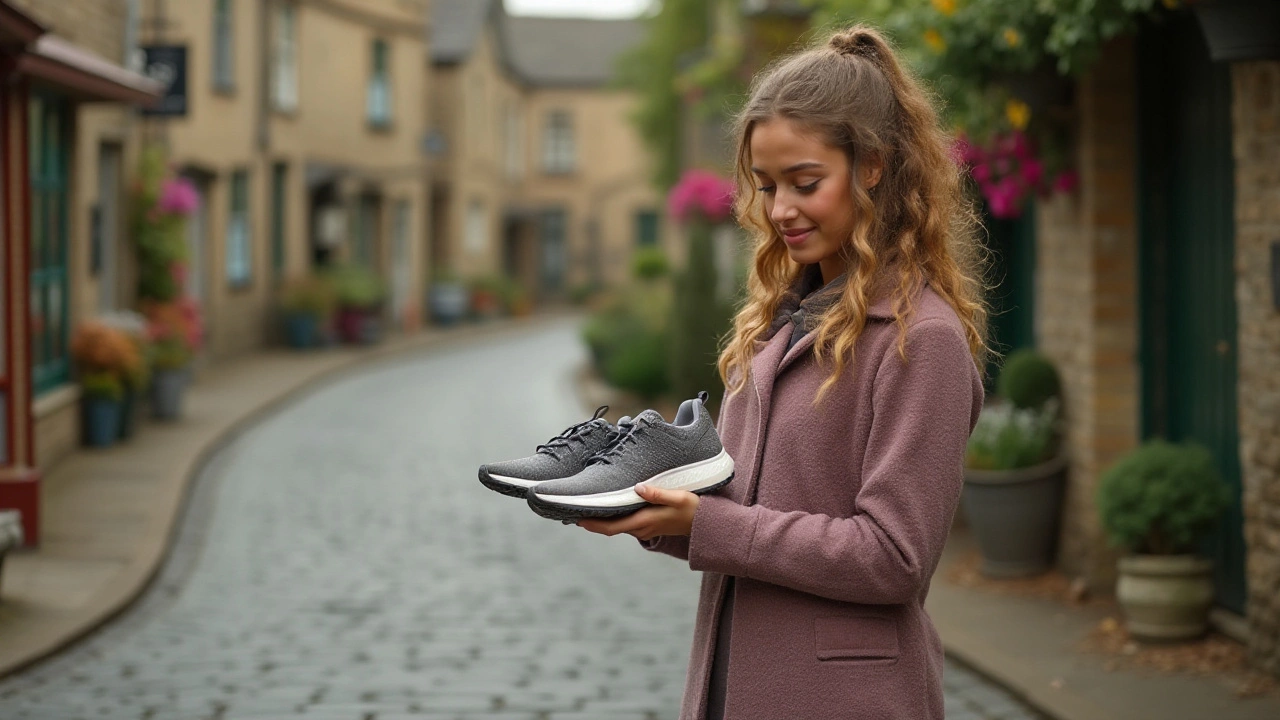Are Running Shoes Harmful When Used for Walking?

In the world of footwear, not all shoes are created equal, especially when it comes to the divide between running and walking shoes. While they might look similar at first glance, the distinctions in their design serve very specific purposes. This raises a commonly overlooked question: is it bad for your feet to use running shoes for walking daily?
Running shoes are crafted to handle the high-impact forces distributed during a run, providing cushioning and support in key areas. On the other hand, walking shoes are tailored for more extended periods of low-impact activity, emphasizing stability and comfort. Wearing a shoe designed for one purpose during another activity can potentially alter the benefits and, in some cases, lead to discomfort or injury.
This article will guide you through the intricacies of shoe designs and their implications on your foot health. We'll examine when it's appropriate to interchange these shoes and when it's better to stick with the intended design. Along the way, you'll pick up some useful tips to maintain foot health no matter what shoe you choose to lace up.
- Understanding Shoe Design Differences
- Impact on Foot Health
- When to Choose Walking Over Running Shoes
- Foot Care Tips for Shoe Users
- Making an Informed Shoe Choice
Understanding Shoe Design Differences
Deciphering the design intricacies between walking and running shoes is akin to examining two distinct art forms. Both aim to cradle the feet with comfort, yet the ways in which they achieve this are remarkably disparate. At the heart of the design differences lies the fundamental activities these shoes are crafted for – walking, a rhythmic and steady forward motion, versus running, a dynamic leap that subjects the foot to repetitive high-impact forces. The magic of a well-designed shoe lies in its construction, which tailors to the specific needs and stresses placed upon the foot during these movements. As a walker strides, the heel-to-toe transition is gradual, demanding stability and a balanced sole. In contrast, running involves a unique and sometimes brutal foot strike that calls for extra cushioning and a flexible design to absorb shock and protect joints.
If we delve into the anatomy of a typical walking shoe, we find a firm and flat sole. This provides the stability needed for a smooth movement, especially over less forgiving terrains. The flexibility across the forefoot ensures that the foot can comfortably roll through the step. The heel of a walking shoe often contains a low profile to keep walkers closer to the ground, enhancing balance and reducing the risk of ankle twists. Meanwhile, running shoes come with higher heels and employ a more pronounced heel-to-toe drop. This design serves to alleviate the stress placed on the Achilles tendon, allowing runners to glide effortlessly through their paces without putting unnecessary strain on their legs.
A deeper inspection of the materials used also reveals notable differences. Walking shoes often employ denser, more durable materials that offer longevity and resilience, perfect for enduring long routes or commutes. Running shoes, by contrast, typically use breathable, lighter materials with high resilience foams designed to handle the quick pace and frequent impacts. The irony, perhaps, is that the very features enhancing performance for one activity could impede it in another. Running shoes can be less supportive for walking, leading to potential discomfort over time. An insightful observation from biomechanics expert Dr. Louise Langford sums it up well in her comparison:
"Running shoes are like sports cars – built for speed and agility. Walking shoes are the reliable sedans, offering a smooth and steady ride wherever you need to go."Recognizing these differences isn't merely a lesson in shoe design; it's a step toward preserving your own comfort and health, ensuring each stride is as pleasant as the last.
Impact on Foot Health
When considering the impact of wearing running shoes while walking, it's essential to understand the fundamental differences they can impose on foot health. Running shoes are explicitly designed for the stress of intense propulsion, offering extra cushioning and a more flexible sole. This design supports the forward movement and reduced heel impact typical in running. In contrast, during walking, your foot's movement is more straightforward and involves a heel-to-toe transition, requiring a distinct type of support. The structure of walking shoes, therefore, emphasizes stability and comfort with more arch support and a sole built to accommodate the natural roll of the foot.
One of the primary concerns when walking in running shoes is the difference in cushioning. Running shoes often have thicker heel padding to absorb shock over shorter bouts of intensive movement. Prolonged use during walking can lead to an imbalance, as the exaggerated cushioning may cause your body to lean forward, potentially altering your gait. This shift can result in unnecessary strain on your lower back, knees, or hips over time. A flat and stable surface found in walking shoes ensures a more natural gait during extended walking periods.
Notably, using the wrong shoe type might affect foot health by ignoring the biomechanical needs of the activity. A walking shoe's design caters to support during the repetitive, low-impact motion of walking. If relied on continuously, running shoes might not adequately support the arch and may not prevent the common fatigue associated with prolonged low-impact activities.
According to Dr. Irene Davis, a biomechanical researcher, 'Choosing the appropriate shoe for the activity is crucial in maintaining good foot health and preventing issues related to misalignment or overuse.'Wearing a shoe designed for a different activity could exacerbate pre-existing conditions such as plantar fasciitis, which requires careful choice of comfortable, supportive sneakers.
Understanding these differences allows us to make informed choices about our footwear. It's suggested to match the shoe with the tasks you anticipate most often, rather than opting for a one-size-fits-all solution. If you identify with daily long walks or standing, prioritizing footwear that can support your foot's longitudinal arch through its design is crucial. Remember, both walking and running shoes have unique roles, and using them mindfully can prevent potential foot health issues related to inappropriate footwear use. Data also support this process: a study from the Journal of Athletic Training found that individuals wearing footwear tailored specifically to their activity type face 40% fewer foot injuries compared to those who don't.

When to Choose Walking Over Running Shoes
Deciding when to opt for walking shoes instead of their running counterparts can hinge upon the nuances of your daily routine and the activities you engage in. Walking shoes are specifically designed to provide stability and cater to the unique motion of walking, which is fundamentally different from running. Unlike running shoes, which have more cushioning to absorb the impact of high-intensity activity, walking shoes ensure your feet stay aligned with a firm midsole. This helps maintain a healthy gait cycle.
If your day consists of extended periods of walking, perhaps during leisurely strolls, commutes, or exploratory urban hikes, a dedicated walking shoe might be your best bet. Different studies emphasize how the repetitive motion of walking requires a shoe that encourages a proper roll-through from heel to toe. For instance, a report by the American Podiatric Medical Association highlights that walking shoes are built with slightly raised heels, enhancing the natural walking movement.
From an ergonomic perspective, wearing walking shoes ensures each step receives uniform distribution of weight, reducing the risk of conditions like plantar fasciitis and joint strains. If you often find yourself navigating uneven surfaces or prefer more stability, the structured build of walking shoes can offer that essential support. The slightly heavier and more durable composition is tailored specifically for such terrains.
"Walking shoes are designed to address the repetitive movements associated with walking, while still ensuring comfort and support," says Jane Andersen, a respected podiatrist. This insight is especially critical if you plan to spend hours on your feet, as running shoes might lack the necessary lateral support, tipping the balance in favor of a walking-specific option.
For those with specific foot conditions or chronic pain issues, choosing the right shoe can be a therapeutic decision. Many walking shoes come equipped with features like motion control, arch support, and a wider toe box, which help accommodate and alleviate foot conditions such as flat feet or bunions. According to podiatrists, these features are not typically prioritized in running shoes.
Ultimately, the decision between walking and running shoes should be informed by the nature of your activities and personal comfort. A good rule of thumb is to match your shoe choice to the primary activity you intend to perform. By doing so, you'll not only enhance performance and enjoyment but also safeguard your foot health in the process. The insights shared here aim to guide you through making an informed choice, ensuring your footwear meets your specific needs without compromise.
Foot Care Tips for Shoe Users
For anyone who enjoys being active, taking care of your feet is absolutely essential. The shoes you wear play a huge role in maintaining foot health, but there are other steps you can take to ensure that your feet are well looked after. First off, it's crucial to find the right fit. Feet swell throughout the day, so trying on shoes in the late afternoon or evening can help ensure that you'll have the snug, but not tight fit that promotes healthy movement and offers adequate support. Remember, running shoes are designed differently from walking shoes, catering to the unique shapes and motions of their respective activities, which makes choosing the correct one for your activity incredibly important.
Flexible soles are another aspect to look for in both types of shoes, as they allow the natural bending of your foot. A shoe that's too stiff can interfere with your foot's normal functioning, leading to potential aches in your arches or heels. Speaking of heels, not everyone's feet are created equal in terms of their heel shape or arch height. For someone with flat feet, choosing a shoe with ample arch support could mitigate discomfort and help avoid overpronation. Meanwhile, those with a higher arch may benefit from shoes with additional cushioning to absorb impact.
Proper shoe care also plays into foot health. Shoes should be allowed time to air out after each use, especially if they're used in sweaty environments, such as a long run or a walk on a hot day. This moisture can breed bacteria, increasing foot odor and potentially leading to infections. Rotating your shoes, rather than wearing the same pair every single day, gives them a chance to breathe and retain their structural integrity longer.
"A good practice is to have at least two pairs of usable shoes in rotation," suggests Dr. Megan Leahy from the Illinois Bone & Joint Institute.Regularly inspecting your shoes for signs of wear, like uneven soles or damaged cushioning, is vital, as worn-out shoes can affect your gait and posture, leading to discomfort or injury.
Another effective way to care for your feet is through exercises that loosen and strengthen the muscles there. Regular stretching of the toes and calves can prevent the stiffness that sometimes follows a long session of wearing tight shoes. Simple exercises, like rolling your foot over a small ball, can promote flexibility and relieve tension. Pay attention to any pain that persists beyond the typical soreness, as this could be a sign to switch up your shoe game or consult with a podiatrist for more personalized advice. And if blisters are a recurring issue, consider snug socks that wick moisture away and fit without a lot of bunching.
Lastly, don't underestimate the power of good hygiene. Washing your feet daily and applying moisturizer can prevent cracked skin, which is a common issue in colder months when the air is dry. Keeping your toenails trimmed reduces the risk of painful ingrown nails and helps maintain overall foot health. Remember, taking these simple but effective steps can go a long way in keeping your feet happy and healthy, whether you're a fan of tackling miles in running shoes or prefer a leisurely stroll in your walking shoes.

Making an Informed Shoe Choice
When it comes to putting your best foot forward, choosing the right shoe is more crucial than you might think. Deliberating between running shoes and walking shoes isn't just about style or color but boils down to functionality and foot health. Running shoes and walking shoes are crafted with different intentions, and understanding these can significantly impact your choice. Running shoes are often built with extra padding in the heel and a design catered to forward momentum, while walking shoes typically feature a more flexible bend at the front since walking involves long periods with the foot flat. This difference might not seem like much at a glance, but the repercussions can create a world of difference in comfort and safety. For someone clocking miles on foot, the wrong shoe can turn a stroll into a marathon of pain.
Foot health experts generally agree that using the right shoes for your activity can prevent several common injuries. According to a study published in the Journal of Foot and Ankle Research, improper footwear is cited as a leading cause of plantar fasciitis and Achilles tendonitis, both of which can significantly sideline your walking or running efforts. Each time your sole strikes the ground, it places stress on different parts of the feet. If your shoes don't offer the right support, your feet compensate, which leads to pain and potential injury. This is essential knowledge because our everyday decisions, like shoe choice, drastically affect our physical wellbeing.
"Choosing the appropriate footwear for distinct activities such as running and walking isn't merely a matter of comfort, it's an investment in your long-term joint health," says Dr. Emily Splichal, a foot and ankle specialist.
To make an informed decision, assess your primary activities and consult with a footwear specialist or a podiatrist if possible. A fitting session often takes into account factors such as arch type, gait analysis, and any pronation issues you might have. It's beneficial to try shoes on at the end of the day when your feet have naturally expanded to their full size. Properly considering sizing, which includes allowing a thumbnail's length of space between your longest toe and the shoe's end, is advice experts swear by. While brands have their own sizing system, the feel and fit of the shoe are ultimately what matters. Just because it fits in length doesn't mean it provides the structural support needed for your unique stride.
Considerations for Specific Foot Health
Once you have the basics down, consider any specific foot concerns or conditions you might face. If you suffer from flat feet, seek shoes with adequate arch support; those with high arches should look for cushioning. Stability shoes are ideal if you overpronate, while individuals who supinate or underpronate often need a more cushioned, flexible shoe. A foot-type specific approach can help eliminate persistent pain and guards against chronic conditions that improper footwear can exacerbate. In foot health, the golden rule is never to compromise on quality. With countless brands and styles to choose from, it's wise to invest in shoes that promise durability and structure tailored to your movement. Within reason, prioritize fit and function over sleek marketing and aesthetics.
- Identify your primary activities.
- Consult specialists when possible.
- Pay meticulous attention to fit and feel.
- Consider foot conditions like arches or pronation.
- Invest in quality and comfort first.
In a study by the American Orthopaedic Foot & Ankle Society, nearly 90% of women wear shoes that are too small, leading to chronic foot issues. Hence, making an informed choice isn’t just smart, it’s fundamental. Keeping these tips and insights in mind will not only enhance your performance but preserve your foot health for the miles ahead. So, the next time you're staring down a wall of sneakers, you'll know exactly which pair is fit to carry you where you need to go.
